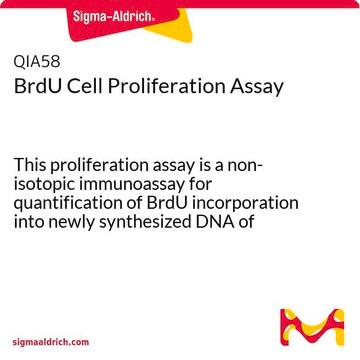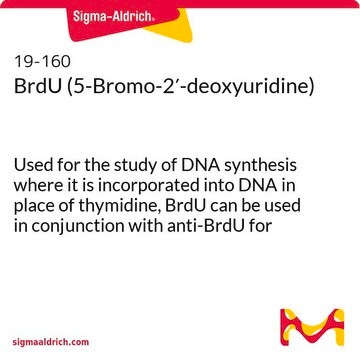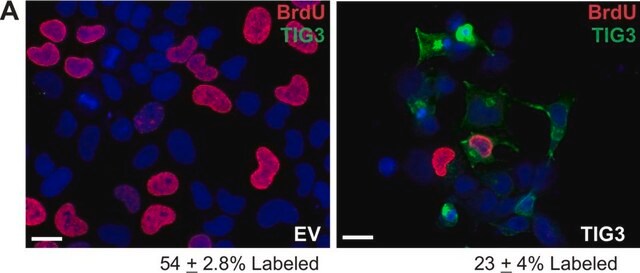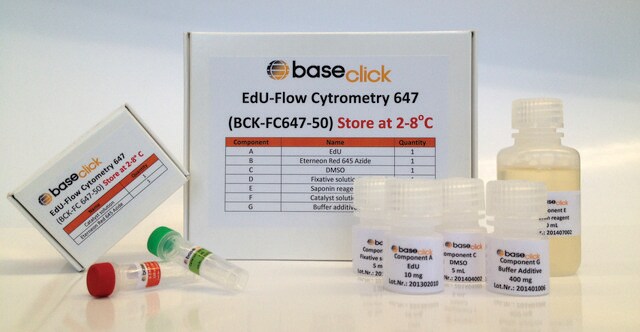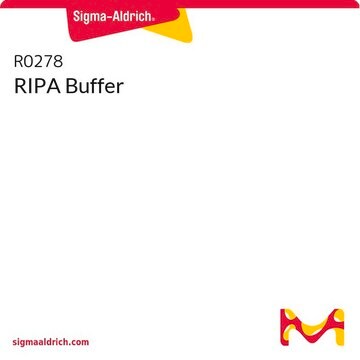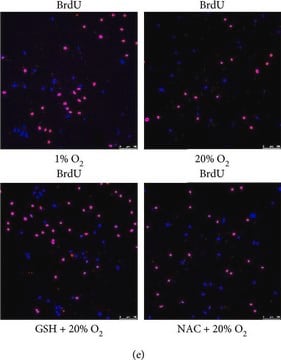11299964001
Roche
5-Bromo-2′-deoxy-uridine Labeling and Detection Kit II
sufficient for ≤100 tests, storage temp.:-20°C
Synonym(s):
5-BrdU, 5-Bromo-2-deoxyuridine
Sign Into View Organizational & Contract Pricing
All Photos(1)
About This Item
UNSPSC Code:
41116133
Recommended Products
usage
sufficient for ≤100 tests
manufacturer/tradename
Roche
storage temp.
−20°C
General description
Cell proliferation may be studied by monitoring the incorporation of a radioisotope, [ 3H]-thymidine, into cellular DNA, followed by autoradiography.
Alternatively, 5-bromo-2′-deoxy-uridine (BrdU) may be used instead of thymidine. Cells that have incorporated BrdU into DNA are easily detected using a monoclonal antibody against BrdU and an enzyme- or fluorochrome-conjugated second antibody.
Alternatively, 5-bromo-2′-deoxy-uridine (BrdU) may be used instead of thymidine. Cells that have incorporated BrdU into DNA are easily detected using a monoclonal antibody against BrdU and an enzyme- or fluorochrome-conjugated second antibody.
Immunohistocytochemical assay for the detection of 5-bromo-2′-deoxy-uridine (BrdU) incorporated into cellular DNA.
Specificity
Anti-BrdU monoclonal antibody specifically binds to 5-bromo-2′-deoxy-uridine, and shows cross-reactivity with 5-iodo-2′-deoxy-uridine (10%). Anti-BrdU shows no cross-reactivity with 5-fluoro-2′-deoxy-uridine or any endogenous cellular component, such as thymidine or uridine.
Application
5-Bromo-2′-deoxy-uridine Labeling and Detection Kit II has been used in:
- labeling of tooth roots for histology
- immunostaining of mice frontal sections
- immunofluorescence imaging of hepatocellular carcinoma sections
The kit is used for the detection of BrdU incorporated into cellular DNA by immunohistocytochemistry.
Features and Benefits
- Safe: No radioisotopes are used.
- Easy to perform: Follows a standard immunohistochemistry protocol.
- Sensitive: Denaturation of DNA with nucleases allows for highly sensitive detection of BrdU.
- Flexible: Allows double-labeling protocols.
Packaging
1 kit containing 7 components.
Principle
Samples prelabeled with BrdU are fixed with ethanol, then incubated with a monoclonal antibody to BrdU, which contains an optimized mixture of nucleases. These nucleases generate single-stranded DNA fragments that allow binding of the antibody to BrdU. Next, an alkaline phosphatase (AP)-labeled antibody to mouse immunoglobulin is added, then bound to the anti-BrdU antibody. The sample is then incubated with the AP substrate and NBT/ BCIP, which is metabolized to form a colored reaction product. The sample is evaluated using a phase-contrast microscope.
Preparation Note
Working concentration: Working concentration of the labeling reagent corresponds to the WC of the In Situ Cell Proliferation Kits.
Sample material:
Cell culture: adherent cells, suspension cells, organ or explant cultures. Frozen or paraffin-embedded tissue sections (after in vivo labeling).
Sample material:
Cell culture: adherent cells, suspension cells, organ or explant cultures. Frozen or paraffin-embedded tissue sections (after in vivo labeling).
Other Notes
For life science research only. Not for use in diagnostic procedures.
Kit Components Only
Product No.
Description
- BrdU Labeling Reagent 1,000x concentrated
- Washing Buffer concentrate 10x concentrated
- Incubation Buffer
- Anti-BrdU antibody, contains nucleases for DNA denaturation
- Anti-mouse Ig-alkaline Phosphatase antibody
- NBT
- BCIP
signalword
Danger
Hazard Classifications
Acute Tox. 4 - Acute Tox. 4 Inhalation - Eye Irrit. 2 - Flam. Liq. 3 Dermal - Muta. 1B - Repr. 1B - Skin Sens. 1
Storage Class
3 - Flammable liquids
wgk_germany
WGK 2
flash_point_f
136.4 °F
flash_point_c
58 °C
Choose from one of the most recent versions:
Already Own This Product?
Find documentation for the products that you have recently purchased in the Document Library.
Customers Also Viewed
L J Backman et al.
Scandinavian journal of medicine & science in sports, 23(6), 687-696 (2012-02-02)
The histopathology of tendons with painful tendinopathy is often tendinosis, a fibrosis-like condition of unclear pathogenesis characterized by tissue changes including hypercellularity. The primary tendon cells (tenocytes) have been shown to express adrenoreceptors (mainly alpha-2A) as well as markers of
Pten regulates neural crest proliferation and differentiation during mouse craniofacial development
Yang T, et al.
Developmental Dynamics, 247(2), 304-314 (2018)
Pten regulates neural crest proliferation and differentiation during mouse craniofacial development.
Tianfang Yang et al.
Developmental dynamics : an official publication of the American Association of Anatomists, 247(2), 304-314 (2017-11-09)
The phosphatase and tensin homolog deleted on chromosome TEN (Pten) is implicated in a broad range of developmental events and diseases. However, its role in neural crest and craniofacial development has not been well illustrated. Using genetically engineered mouse models
CXCL14 and MCP1 are potent trophic factors associated with cell migration and angiogenesis leading to higher regenerative potential of dental pulp side population cells
Hayashi Y, et al.
Stem Cell Research & Therapy, 6(1), 111-111 (2015)
Fenglei He et al.
Development (Cambridge, England), 144(21), 4026-4036 (2017-09-28)
Craniosynostosis is a prevalent human birth defect characterized by premature fusion of calvarial bones. In this study, we show that tight regulation of endogenous PDGFRα activity is required for normal calvarium development in the mouse and that dysregulated PDGFRα activity
Articles
Cell based assays for cell proliferation (BrdU, MTT, WST1), cell viability and cytotoxicity experiments for applications in cancer, neuroscience and stem cell research.
Our team of scientists has experience in all areas of research including Life Science, Material Science, Chemical Synthesis, Chromatography, Analytical and many others.
Contact Technical Service

